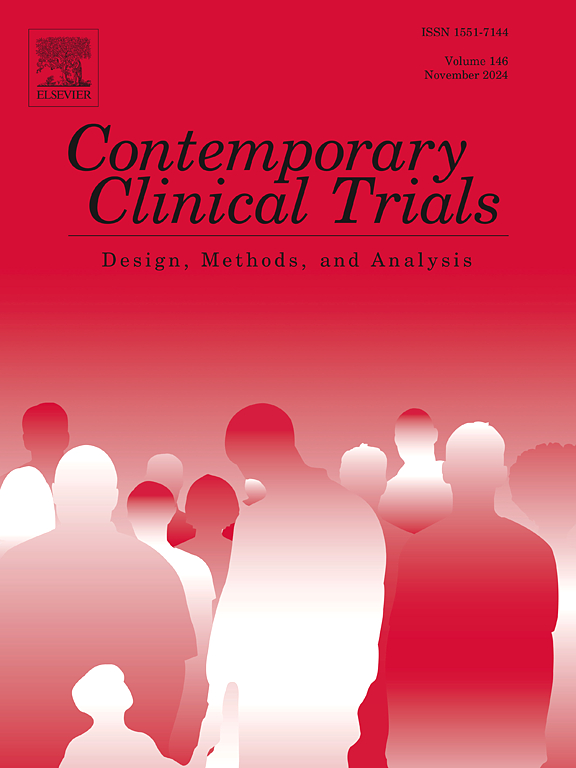4青年对青年(4YBY)众包艾滋病毒预防干预:尼日利亚青少年和年轻人接受艾滋病毒自我检测的阶梯形纵向试验
IF 2
3区 医学
Q3 MEDICINE, RESEARCH & EXPERIMENTAL
引用次数: 0
摘要
青少年和年轻人(AYAs)参与艾滋病毒控制的方法在中低收入国家有所增加,但很少有试验来评估有效性。我们在尼日利亚的一个AYA队列中评估了一种众包艾滋病毒自我检测(HIVST)干预。方法我们进行了一项实用的阶梯形聚类随机对照试验,从尼日利亚四个地缘政治区域的32个地方政府区域招募参与者(14-24岁)。合格的AYA是HIV阴性或未知的HIV状态,居住在研究地点,会说英语,并同意。这些区域被随机分配到四个步骤中的一个,AYA被跟踪了24个月。美国艾滋病协会的研究促进者实施了一项4YBY众包艾滋病预防捆绑计划。主要结果是自我报告的hiv感染情况。我们使用广义线性混合模型比较了控制期和干预期艾滋病病毒感染的概率。我们考察了干预的固定成本和人均成本。该方案已于2021年1月15日在Clinical Trials.gov注册,注册号为NCT04710784。结果筛选2652例AYA, 1500例入组(2021年3月10日- 2023年8月31日)。随访24个月1333/1500例(89%)。AYA的平均年龄为20±2.65岁,以学生(1155/1500,77%)和无业人员(915/1500,61%)居多。与对照组相比,干预导致艾滋病毒自检率增加了9.96倍(95% CI: 8.36-11.85, p <;0.0001)。干预措施的年度固定费用估计为42,237美元,人均检测费用为14.8美元。无明显不良事件报道。结论众包HIV预防干预提高了尼日利亚AYA人群的HIV感染率。为了实现艾滋病规划署的目标,需要更多地参与临床试验的设计和实施。本文章由计算机程序翻译,如有差异,请以英文原文为准。
The 4 youth by youth (4YBY) crowdsourced HIV prevention intervention: A stepped-wedge longitudinal trial on HIV self-testing uptake among adolescents and young people in Nigeria
Adolescents and young adults (AYAs) participatory approaches for HIV control have increased across LMICs, but there are few trials to evaluate effectiveness. We assessed a crowdsourced HIV self-testing (HIVST) intervention among a cohort of AYA in Nigeria.
Methods
We conducted a pragmatic stepped-wedge cluster randomized control trial recruiting participants (aged 14–24 years) from 32 local government areas across four geo-political zones in Nigeria. Eligible AYA were HIV negative or unknown HIV status, residing in study sites, spoke English, and consented. Areas were randomly assigned to one of four steps and AYA were followed for 24 months. AYA research facilitators implemented a 4YBY crowdsourced HIV prevention bundle. The primary outcome was self-reported HIVST uptake. We compared the probability of HIVST between the control and intervention periods using a generalized linear mixed model. We examined the fixed cost and per capita cost of the intervention. The protocol was registered with Clinical Trials.gov on January 15, 2021, under registration NCT04710784.
Results
2652 AYA were screened, and 1500 were enrolled in the study (March 10, 2021- August 31, 2023). 1333/1500 (89 %) were followed up at 24 months. The mean age of AYA was 20 ± 2.65 years old, most were students (1155/1500, 77 %), and unemployed (915/1500, 61 %). The intervention led to a 9.96-fold increase in HIV self-testing uptake compared to the control period (95 % CI: 8.36–11.85, p < 0.0001). The annual fixed cost of the intervention was estimated at US$42,237, with a per capita testing cost of US$14.8. No significant adverse events were reported.
Conclusion
A crowdsourced HIV prevention intervention increased HIVST uptake among Nigerian AYA. Greater participation of AYA in the design and implementation of clinical trials is needed to achieve UNAIDS targets.
求助全文
通过发布文献求助,成功后即可免费获取论文全文。
去求助
来源期刊
CiteScore
3.70
自引率
4.50%
发文量
281
审稿时长
44 days
期刊介绍:
Contemporary Clinical Trials is an international peer reviewed journal that publishes manuscripts pertaining to all aspects of clinical trials, including, but not limited to, design, conduct, analysis, regulation and ethics. Manuscripts submitted should appeal to a readership drawn from disciplines including medicine, biostatistics, epidemiology, computer science, management science, behavioural science, pharmaceutical science, and bioethics. Full-length papers and short communications not exceeding 1,500 words, as well as systemic reviews of clinical trials and methodologies will be published. Perspectives/commentaries on current issues and the impact of clinical trials on the practice of medicine and health policy are also welcome.

 求助内容:
求助内容: 应助结果提醒方式:
应助结果提醒方式:


